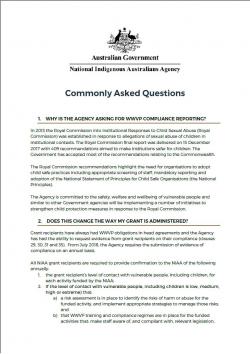WWVP Commonly Asked Questions

Commonly asked questions about Working with Vulnerable People compliance reporting.
1. Why is the agency asking for WWVP Compliance Reporting?
In 2013 the Royal Commission into Institutional Responses to Child Sexual Abuse (Royal Commission) was established in response to allegations of sexual abuse of children in institutional contexts. The Royal Commission final report was delivered on 15 December 2017 with 409 recommendations aimed to make institutions safer for children. The Government has accepted most of the recommendations relating to the Commonwealth.
The Royal Commission recommendations highlight the need for organisations to adopt child safe practices including appropriate screening of staff, mandatory reporting and adoption of the National Statement of Principles for Child Safe Organisations (the National Principles).
The Agency is committed to the safety, welfare and wellbeing of vulnerable people and similar to other Government agencies will be implementing a number of initiatives to strengthen child protection measures in response to the Royal Commission.
2. Does this change the way my grant is administered?
Grant recipients have always had WWVP obligations in head agreements and the Agency has had the ability to request evidence from grant recipients on their compliance (clauses 29, 30, 31 and 35). From July 2018, the Agency requires the submission of evidence of compliance on an annual basis.
All NIAA grant recipients are required to provide confirmation to the NIAA of the following annually:
-
the grant recipient’s level of contact with vulnerable people, including children, for each activity funded by the NIAA;
-
If the level of contact with vulnerable people, including children is low, medium, high or extreme) that:
-
a risk assessment is in place to identify the risks of harm or abuse for the funded activity, and implement appropriate strategies to manage those risks; and
-
that WWVP training and compliance regimes are in place for the funded activities that: make staff aware of, and compliant with, relevant legislation, including Working with Children Checks and mandatory reporting requirements, in the locations where the activities are being delivered.
-
3. What is the difference between working with vulnerable people and working with children?
State and Territory legislation across Australia varies in regards to WWVP. The Australian Capital Territory and Tasmanian legislation refers to working with vulnerable people which includes children but is broader. Queensland, South Australia, New South Wales and the Northern Territory legislation refers to working with children.
The Agency uses the broader definition, of working with vulnerable people, including children. The definition used in head agreements is as follows:
A vulnerable person means a child, being an individual under the age of 18 or an individual aged 18 years and above who may be unable to take care of themselves against harm or exploitation by reason of a, illness, trauma or disability or any other reason.
4. What are the new reporting requirements?
From 1 July 2018, grant recipients have been required to do the following:
-
Undertake a risk self- assessment to identify their level of responsibility for vulnerable people; and if the level of contact is low, medium, high or extreme:
-
Put in place a risk assessment to evaluate the risks of harm or abuse, and put in place appropriate strategies to manage those risks;
-
Establish a training and compliance regime to ensure their Personnel are aware of, and comply with, relevant legislation including working with vulnerable people and children checks and mandatory reporting requirements; and
-
Confirm grant recipient compliance with relevant legislation for WWVP, such as Working with Children Checks and mandatory reporting requirements, for the locations where the funded activities are being delivered.
-
5. When did the changes come into effect?
The changes came into effect on 1 July 2018.
6. Do the changes apply to grant agreements already in place?
Yes. All Grant Recipients with an existing Head Agreement in place as at August 2018, were sent a Notice of Change on 1 August 2018, requiring compliance with the new reporting requirements.
7. Do the changes apply to new grant agreements?
Yes. In August 2018, the WWVP clauses in the IAS Head Agreement were amended to include the new reporting requirements, so they are standard for organisations signed to the updated IAS Head Agreement.
8. What do i need to provide the NIAA?
To comply with WWVP reporting requirements, grant recipients will need to provide confirmation of the following to the NIAA:
-
the grant recipient’s level of contact with vulnerable people, including children, for each activity funded by the NIAA;
-
If the level of contact with vulnerable people, including children is low, medium high, or extreme:
-
That a risk assessment is in place to identify the risks of harm or abuse for the funded activity, and implement appropriate strategies to manage those risks.
-
That training and compliance regimes are in place for staff regarding WWVP.
-
That the grant recipient complies with all relevant WWVP legislation, such as Working with Children Checks and mandatory reporting requirements, for each funded activity.
-
9. What type of risk assessment will I have to undertake?
Grant recipients must undertake:
- a risk self-assessment to determine their level of contact with vulnerable people, including children for activities funded by the NIAA; and
- a risk assessment assessing the level of risk of harm or abuse to vulnerable people, including children,in relation to activities funded by the NIAA; and implement appropriate strategies to manage those risks.
10. What type of training and compliance regime is required?
Grant recipients with activities rated in the Low, Medium, High or Extreme category for contact with vulnerable people must have in place WWVP compliance and staff training regimes for those activities, to: make staff aware of, and compliant with, relevant legislation, including Working with Children Checks and mandatory reporting requirements, in the locations where the activities are being delivered.
Examples of training regimes that grant recipients may have in place:
- Including WWVP checks in recruitment processes
- Developing WWVP policies and guidance material
- Regular training to staff and relevant third parties on WWVP state and territory legislation
- Education and training on WWVP safety to promote awareness and understanding of risks and organisational responsibilities
- Access to state and territory legislation
- Online training plans
- Induction manuals if any
- Monthly reviews against agreed WWVP checklists
Examples of compliance regimes:
- Regular compliance reviews
- Regular regulation and assessment updates (could include emails or briefing sessions)
- Annual monitoring to ensure ongoing compliance by all relevant staff and third parties
- Up to date registers of the required WWVP registration and checks, criminal history and police checks
- Process and systems to easily update WWVP records by those in an authorised position
- Policies on the immediate and longer term steps to take if a staff member or relevant third party fails to obtain a WWVP registration or check
- Inclusion of WWVP requirements in employment contracts
11. Where can I get further information?
If you have any questions on the new changes please contact your Agreement manager.
Refer to the following links for further information:
- The Royal Commission Final Report
- The National Principles for Child Safe Organisations
- ACT working with vulnerable people registration requirements
- NSW working with children check requirements
- NT Ochre Card requirements
- QLD Blue Card requirements
- SA child-related screening requirements
- TAS working with children registration requirements
- VIC working with children check requirements
- WA working with children check requirements






